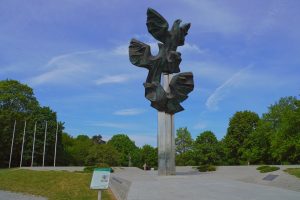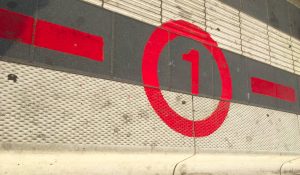Under the main railway station in Szczecin is the largest civilian bunker in Poland. You can visit it on a bunker tour in Szczecin and immerse yourself in an almost forgotten time.

On platform 1 of the Szczecin main station we discover a large glass box that closes the entrance to a staircase. A sign reveals, here is the entrance to a bunker complex from the time of the Second World War. The bunker was built in 1941, but has only been open for the bunker tour in Szczecin since 2006.
Even as we descend the steps, it gets noticeably cooler. Here, deep underground, it is almost constantly 12 degrees, and those who stay there longer should put on something warmer. It is also wise to have some cash in your pocket. Although it is possible to pay the entrance with the card, but the Internet connection is not always so good that the terminal under the station works.
A bunker tour in Szczecin is also possible without a guide. There are three well-signposted routes, each looking at a thematic focus.

Bunker tour in Szczecin
Through large heavy steel gates you enter the bunker under the station. Here, during the Second World War, up to 5000 people found shelter on an area of about 3000 m². The building extends over 5 underground floors, which was converted by Poland after the war for a short time as a nuclear shelter.

You can not get lost. All areas that are open are well signposted and the three routes are well separated by their color markings. The entire exhibition area is described in Polish, German and English. Those who would like to receive the information in another language should ask at the cash desk, there are some more translations to borrow.
Route: “World War II”
The tour starts with the thematic area around the Second World War. You walk through long tunnels and on panels you can learn about the fortification system of Szczecin, the air raid shelters and bunkers built in Szczecin during the Second World War. The corridors are 3 meters high and the length of the largest corridor is 100 meters. It is dim light and I find it oppressive to be walking here.

I find the view of “life” in the air raid shelter during the air raids particularly exciting. There were extra rooms into which people were “sorted”. First of all, you had to show an ID card at the entrance to be able to enter the bunker at all. Only German citizens (Szczecin belonged to Germany at that time) were allowed to seek shelter there. Then there were rooms for women, for children and their guardians, and rooms for men. The room for the children, for example, was the only one with heating.



In some places you can still discover notes and rules written on the wall. There are panels explaining the correct wearing of gas masks.
These depictions alone are quite depressing. In addition, further information about the wartime is presented very impressively. One learns something about the forced transports of the Polish population in the war time, which were brought partly into German work camps in addition, into camps to Siberia. For me, an information circle closes here, as I had just visited a forced labor camp in Berlin and dealt with this topic.

Another theme that is very impressively presented deals with the destruction of Szczecin, the end of German Szczecin, the resettlement and settlement of the population, the first days of Polish Szczecin and the first post-war years.
Route: “Cold War”
The second route deals with the content of the “Cold War” period. You now walk through another area of the bunker, where smaller rooms and no longer long tunnels dominate.

Here you can see quite clearly how the existing rooms have been adapted to the new needs. Cabins with telephone booths were built. The messages received here were then passed on to headquarters.

In one room I discover a large map showing the station area. Here, one has additionally displayed information about the bunker system. Only now do I realize how large this facility must be.

I found it depressing to imagine that the air raid shelter had been converted into a nuclear bunker. Today, for example, one can see into a room where anti-chemical packages are lying. To this day, an unpleasant smell emanates from these packages; they should have helped against contamination in an emergency.
Route: “Selfie with PRL – Communism”
The third and last section of the exhibition in the bunker complex shows colorful and funny-looking elements that are supposed to encourage visitors to take a selfie. I honestly only briefly looked at this section of the exhibition. The area did not fit my mood after the serious and quite thoughtful impressions of the first routes. However, other visitors were enthusiastically taking pictures.

Film shooting location in the bunker under the Szczecin main station
In 1963, scenes were shot in the bunker complex with Steve McQueen for the film “The great escape”. In this film, the events of 1944 are depicted, which actually happened in the turmoil of the Second World War. Two RAF pilots from Norway organized an adventurous escape at that time.


In the Szczecin bunker, some film sets have been rebuilt on the original location.
Address:
Krzysztofa Kolumba 2,
70-035 Szczecin, Polen
Opening hours:
daily: 10-16 h
Admission fees:
Adults: 38,-PLN
Discounts are offered.











Leave a Reply